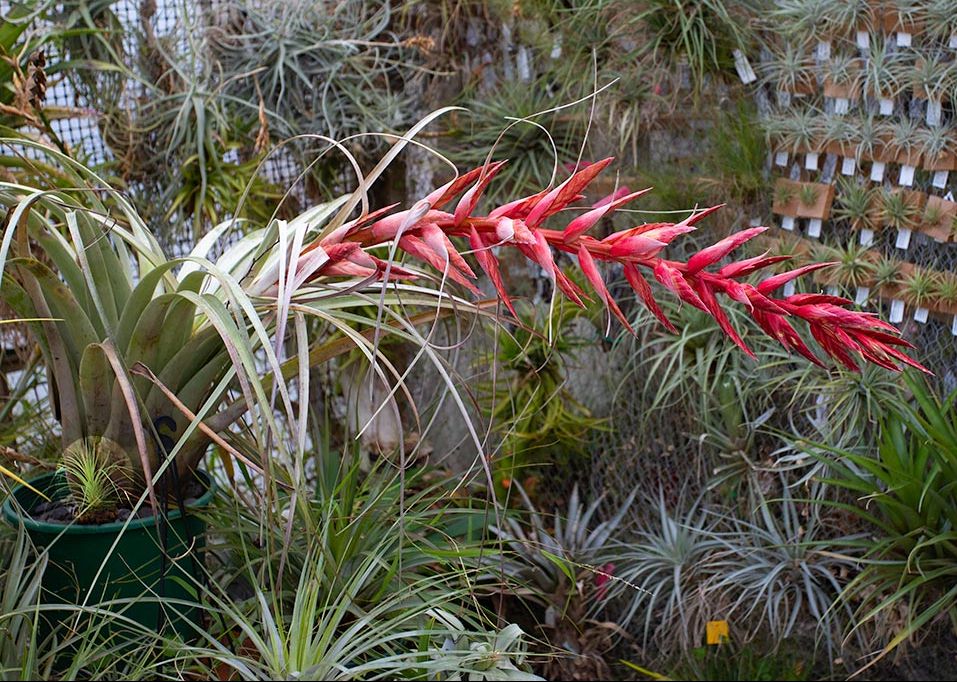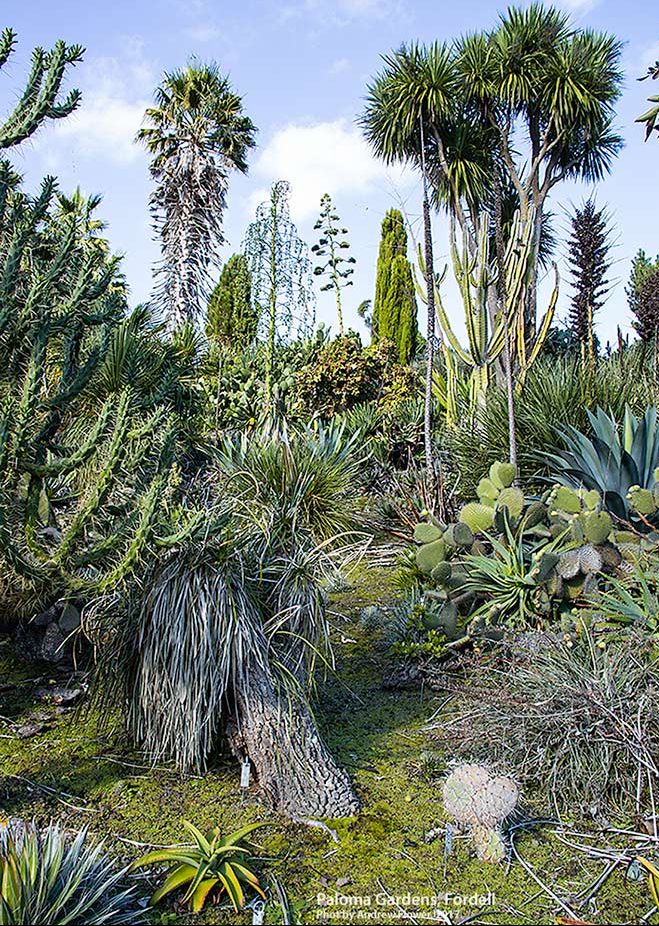

Tillandsia ventosfriosensis (? kermesina) Sp. Nova by Renate Ehlers. Not yet published.
Should this be the name of the T. cossonii which is to my mind was not properly identified and resurrected by Gardner ?
Notes from R Ehlers 2/1996
I do not know how Sue Gardner made sure this plant is T. cossonii. At least the herbarium photo from Walter Till looks very different. Ventos Frios is in Guerro between Milcumbres and Paraiso (where we found T. hromadnikiana and T. paraisoensis) but in the meantime we found the plant near Uruapan, in Michoacan near Cuidad Hidalgo and as well in Oaxaca between Tlaxiaco and Copala. So I thought it might be better to change the name to T. kermesina or something similar as the plant is so spectacular with its bright red inflorescence.
There is also a plant similar to T. hintoniana with lepidote floral bracts(Valle de Bravo) and Lotte Hromadnik and I thought this plant was T. cossonii. But Sue Gardner showed to me the plant we first found near Ventos Frios and said this was T. cossonii. She does not work anymore and is not at all interested in tillandsias. I wrote to her after our visit at her house asking her help on only 2 species including T. cossonii but she never answered me.
Plant - stemless, flowering to 70 cm high, no offsets.
Leaves - 20 - 30 in a funnelform, impounding rosette, to 40cm long, subcoriaceous, dark green.
Sheath - elliptic, distinct, to 15cm long and to 8.5cm wide, adaxial, except the pale basal 3cm, very dark brown, abaxial light brown, both sides very finely adpressed lepidote.
Blade - to 35cm long, 4 - 5cm wide above the sheath, triangular attenuate, spreading, green, nerved, adaxial surface finely punctulate, abaxial densely grey adpressed lepidote.
Scape - erect, very stout, shorter than the leaves.
Scape Bracts - foliaceous, imbricate with red, pendent blades.
Inflorescence - erect, bipinnate, cylindric, to 35cm long, to 18cm in diameter, compound of more than 20 branches, internodes of the lower spikes 2cm.
Branches - spreading to 80º, the apical ones narrower and more erect , axis very stout, lepidote.
Primary Bracts - sheaths 2/3 to 1/2 as long as the spike, broadly ovate, and enfolding its flat side, blades to 20cm long, bright red, foliaceous, reflexed, the apical bracts gradually reduced to 1/3 as long as the spike and merely acute.
Spikes - 5 - 7cm long, 2 - 2.4cm wide, elliptic acute, dorsiventrally compressed with the adaxial side flat, with stout peduncle (1cm long), densely 5 - 7 flowered with 2 - 3 sterile bracts at the base, rhachis angled.
Flowers - sessile, odorless, to 6.5cm long, strictly erect.
Floral Bracts - densely imbricate, concealing the rhachis completely, internodes 4 - 10mm, 2 - 2.7cm long, to 2cm wide at base, ovate-deltoid, acute, 1 - 2mm shorter than the sepals, coriaceous, carinate, conspicuously nerved, adaxial very minutely punctulate lepidote, abaxial green, basal half punctulate, apical half grey lepidote, densely on keel and tip, margins with a dense border of big, asymmetric trichomes.
Sepals - to 2.7cm long, to 1.1cm wide, the anterior one 1mm shorter and narrower, elliptic acute, sub-coriaceous with thin margins, nerved, the anterior one with thick mid-nerve, the posterior ones alate, carinate, and connate for 5 - 7mm, with finely and densely punctulate lepidote, green, glabrous without.
Petals - ligulate, forming an erect tube with slightly revolute apices, corolla throat closed around the filaments at anthesis, postfloral open, 4 - 5cm long, 9mm wide, 6mm wide at base, light green (#79 citron) white towards the base.
Stamens - exceeding the corolla to 1.8cm, Filaments to 6.2cm long, in 2 sets of unequal length, flat, broadened (1.1mm) near apex, many times twisted in basal half, concolourous with the petals.
Anthers 3 - 3.5mm long, 1mm wide, elliptic, attachment versatil dorsifixed 1/4 from base, light brown. Pollen egg-yellow.
Style to 5.5cm long, green, stigma small (not much wider than the style), lobes green, erect, (Type II Brown and Gilmartin 1984).
Ovary 7mm high, 4mm at base, conical, greenish.
Type - Mexico, Guerrero, Road Filo de Caballo - Ventosfrios, 2500 - 2700m in cloudforest. Klaus and Renate Ehlers, 8 and 9 Mar 1990, EM900804 and EM900903, W.U.
Distribution - Additional material collected by Lotte and Helmut Hromradnik, Vienna, Mexico Guerrero, Puerto del Gallo, 2700m HR14084, and Colima, Nevado Colima, 2500m, HR15027. The latter has longer primary bracts with sheaths as long as the spikes.
The plant seems closely related to T. macrochlamys Baker but differs by
1. Leaves adaxially sub-glabrous
2. Inflorescence longer, cylindric not elliptic, with spreading branches
3. Spikes more flowered with stout peduncle
4. Floral bracts strongly nerved, lepidote.
5. Sepals longer than the bracts, punctulate lepidote within, the anterior with thick mid-nerve.
6. Petals longer.
Differs from T. cossonii (Baker) emend Gardner by
1. Leaves shorter with dark brown sheaths.
2. Branches spreading to 80º not only 45º,
3. Primary bracts shorter with blades bright red not green.
4. Floral bracts coriaceous, green not rose, strongly nerved, not conduplicated, only to 2.7cm long
5. Sepals exceeding the bracts, no large brown trichomes on abaxial surface, but adaxially punctulate lepidote, the anterior one with thick mid-nerve.
Material examined.
T. spec. s. n. Mexico 1979 near Guernavaca leg H. Alber, Esslingen, flowering 1989 in col. Alber
EM892601 Mexico, Guerrero, near Taxco, 26.3.1989 leg K & R Ehlers
EM902501 Mexico, Michoacan, Paso de Gato (near Cd. Hidalgo), 25. 3. 1990 leg K & R Ehlers.
Comment. The material examined fits the description by Sue Gardner 1982, but not the Isotype of T. cossonii Baker. Dr Walter Till of University of Vienna found out that the Isotypus of T. cossonii Baker (T. prodigiosa (Lem) Baker 1889, leg Bilimek No. 440, Mexico, prope Orizaba, Deserto, 26. 12. 1865 = Syn. T. cossonii) of the Herbarium ?GH, K, or US does not fit the description. Gardner has it that it has no lepidote floral bracts. (It does not seem possible that all the trichomes were knocked off) Also the branches spread to 90º while the plant emended by Gardner spreads only to 45º. Further investigation is needed.
Differs from T. prodigiosa (Lemaire) Baker by
1. Inflorescence erect, not pendent with very stout axis.
2. Primary bracts with shorter sheaths and reflexed blades.
3. Spikes fewer flowered and narrower.
4. Flowers sessile.
5. Floral bracts strongly nerved.
6. sepals exceeding the floral bracts, shorter, the anterior with mid-nerve, punctulate lepidote within.